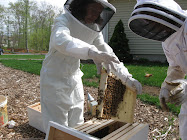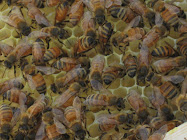Yesterday I started plugging away at my list of to do's. I decided I'd start with cleaning the house because it was cold and drizzling outside, and inside I have brought 'my house is a mess' to a whole new level. It had to be done.
I started frantically with the downstairs, first cleaning the kitchen, putting in a load of wash, stripping the beds, folding some laundry, vacuuming the rugs then the floors . . . then I got the call. The "Your chicks are here and ready to be picked up" call. "Oh" I said, "a day early." Good grief, I'm thinking to myself, I haven't even gotten to setting up their little brood box (although I'd purchased everything I needed). That was tonight's project! "Alright then, I guess I'd better swing by and pick them up!"
I immediately dropped the vacuum where it was (it's still in the hall) and raced around setting up their new home in our basement by the window. Mayhem. I needed to pick up Ripley from preschool later that afternoon (Monday is his long day at school) so I had to finish setting up, race over to Agway, pick up the chicks, bring them home and get them settled before taking off to preschool. Needless to say, the house is not clean yet, but I've made some progress.
Afraid to make a complete spectacle of myself I left my fancy camera at home (Oh boy, look at the silly novice Betty, bringin' the camera) and shot this picture with my cell phone. Here is a good portion of the chicks ordered by area folks who want to keep their own hens. These are all supposed to be hens.
Words can't describe how adorable they are, peeping away, stumbling over everything. These are 'day old' chicks. Chicks can survive without food or water for 48 hours after breaking out of their egg. This is when they were popped in the mail, yes, the mail and sent to our Agway. Everyone gives the Postal Service a bad rap, but did you know that they will deliver day old chicks and packages of bees? Not bad.

There were still two large boxes that they hadn't 'unpacked' yet.
These girls had literally just been picked up from the post office.

Here is the little box containing my 8 little chicks.

And here they are. Awwwwwww.
L-R: New Hampshire Red, Rhode Island Red, Barred Rock (or Plymouth Rock)

After their journey, they were a little pooped out.

A lot of books say to dip the beaks of the chicks in the water to show them where and what it is, then do the same for the food. After a few minutes of getting 'situated' they got busy exploring and went right to eating and drinking. No problem.

I've seen a lot of people use paper plates just to get them started, but they immediately started standing in it, then in short order -- pooing in it. So, the plate had to go. After they figured out the plate, I put the chick feeder right next to it and they got the hang of it right away. So, off with the plate.
They were sorry to see it go though, because they sure had fun scratching and pecking in it. I think I will get a little sand for them to sprinkle on top of their litter and maybe their food. All of the books talk about giving your chicks / chickens grit, particularly if you are supplementing their diet with scraps, veggies and fruits, because chickens don't have teeth so they need little pebble-like things to crunch their food up. Plus, it seems to me, they just like pecking and scratching at it. But, my Agway doesn't carry it. I guess most people just use sand? If your birds are outside scavenging around, they find their own 'grit' laying around. But, it's still good to give them a supply, to be sure.

Dangling over their brood box is a heat lamp. Baby chicks need to be warm. In their box they need a range of temperatures from 73-95 degrees (this is why you see the thermometer in the box). You adjust the temperature by raising or lowering the heat lamp. If they all scatter to the outside edges of the box, they are too hot. If they are all huddled in the center under the lamp, they are too cold. If they are meandering all around in different places, eating and drinking . . . they are just right. This has been a bit stressful for me. I can't tell you how many times I've raised and lowered that silly lamp. I'm realizing that I am a worry wart of a mother. Now I understand my Grandmom (Mom's side) better. It comes from loving 'too much' and wanting to do a good job. I worry that when I go downstairs in the morning my chicks will be laying on their sides with rigamortis because I had the heat lamp too low, or too high! I worry that my bees will swarm because of lack of attention on my part. I worry that my children will fall on their heads from the swing set and break their necks. I know, I know, Matthew 6: 25-34!
When I was watching them yesterday it really seemed to me that they needed a gerbil wheel or something. They need some toys. They seemed a bit bored with what I had to offer them. I was dying to put a couple rips of lettuce in there, but I read online that they aren't ready for such things. Too bad. I think they would have had a lot of fun pecking at it.
Names you ask? My boys have never been big on names. They come up with names such as this: For a penguin: Pengy. For a dog: Doggy. Last night when Victor came home he volunteered Tom, Dick and Harry. In unison we all said "They are giiiiiiiiiiiirllllllllssssssss". "Okay, Henrietta then" Victor corrected. Good grief. I can see I'm going to have help with some suggestions.














































































